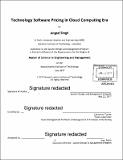| dc.contributor.advisor | Catherine Tucker. | en_US |
| dc.contributor.author | Singh, Angad, S.M. Massachusetts Institute of Technology | en_US |
| dc.contributor.other | System Design and Management Program. | en_US |
| dc.date.accessioned | 2018-02-08T16:27:46Z | |
| dc.date.available | 2018-02-08T16:27:46Z | |
| dc.date.copyright | 2017 | en_US |
| dc.date.issued | 2017 | en_US |
| dc.identifier.uri | http://hdl.handle.net/1721.1/113527 | |
| dc.description | Thesis: S.M. in Engineering and Management, Massachusetts Institute of Technology, System Design and Management Program, 2017. | en_US |
| dc.description | Cataloged from PDF version of thesis. | en_US |
| dc.description | Includes bibliographical references. | en_US |
| dc.description.abstract | The Software Industry has been constantly growing and setting path-breaking trends over the years. Cloud Computing is one such innovation that has brought a sea of change in the way people build and use software. Businesses are shifting their perspective from a model based on 'software ownership' to a model based on 'software as a service'. This paradigm shift in the industry has forced established software vendors to reinvent their businesses by offering products in form of services. The change in 'software ownership' dynamics also warrants a change in the pricing strategy. A popular alternative to the traditional perpetual licensing model is a subscription pricing model. This involves the consumers paying a fixed amount periodically to get the software service, instead of paying a large amount upfront to own the software. The study is designed primarily to compare the effectiveness of the subscription model over the traditional perpetual licensing model, with the help of a case study of Adobe Systems Incorporated. The company is a good choice as it switched from the perpetual licensing model to subscription model in 2012. The study concludes that, while no single model is entirely perfect on all grounds, a pricing strategy based on the subscription model could be an effective strategy for any organization to increase its revenue and maintain customer satisfaction at the same time. The strategy enables the organizations to get more revenue from their subscribers over a longer period of time. It also reduces the upfront cost paid by users, making it more affordable which would help increase the number of subscribers. | en_US |
| dc.description.statementofresponsibility | by Angad Singh. | en_US |
| dc.format.extent | 62 pages | en_US |
| dc.language.iso | eng | en_US |
| dc.publisher | Massachusetts Institute of Technology | en_US |
| dc.rights | MIT theses are protected by copyright. They may be viewed, downloaded, or printed from this source but further reproduction or distribution in any format is prohibited without written permission. | en_US |
| dc.rights.uri | http://dspace.mit.edu/handle/1721.1/7582 | en_US |
| dc.subject | Engineering and Management Program. | en_US |
| dc.subject | Integrated Design and Management Program. | en_US |
| dc.subject | System Design and Management Program. | en_US |
| dc.title | Technology software pricing in cloud computing era | en_US |
| dc.type | Thesis | en_US |
| dc.description.degree | S.M. in Engineering and Management | en_US |
| dc.contributor.department | Massachusetts Institute of Technology. Engineering and Management Program | en_US |
| dc.contributor.department | System Design and Management Program. | en_US |
| dc.contributor.department | Massachusetts Institute of Technology. Integrated Design and Management Program | en_US |
| dc.identifier.oclc | 1020172130 | en_US |
